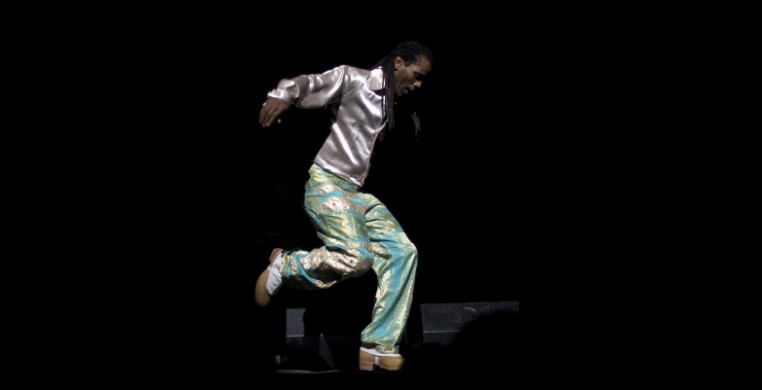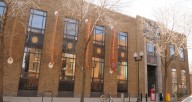On November 8, 1989, a joint resolution was passed by the House of Representatives and the Senate proclaiming that May 25th would be hereby known as National Tap Dance Day. On the Senate floor, the proposal was read aloud by then delegate from Delaware, Joseph Biden, and signed into public law by the then President of the United States, George H.W. Bush. Included in the resolution was the following call to action:
“The President is authorized and requested to issue a proclamation calling upon the people of the United States to observe such a day with appropriate ceremonies and activities.”
This year, Chicago tap dancers celebrated the holiday appropriately with improvisatory tap jams, special-guest dance workshops, “footage” watching parties and full-length performances. “National Tap Day, Chicago Style” presented by the Old Town School of Folk Music stands out as a love letter to the legacy of tap dance. Hosted by resident artist Reggio “The Hoofer” McLaughlin—2021 recipient of the National Endowment for the Arts’ National Heritage Fellows award—
Mclaughlin is a self-proclaimed “national treasure.” Judging by the cheering crowd that packed the Gary and Laura Maurer Concert Hall on June 4, he may be right.
The evening’s performance began with an introduction to tap’s roots in early 20th century jazz music and dance. Before the performance, a seven-piece band and conductor warmed up the crowd with a couple of jazz standards. The first act, a swingin’ trio of harmonizing vocalists, was followed by two experienced Lindy Hoppers, “Johnny & Marsha,” who elicit gasps from the audience during daring dips and swing-through-the-legs specialties. A chorus line of women dressed in fringy flapper dresses demonstrate the shared origin between tap and jazz dance by performing steps that served as precursers for both styles, like the leg-crossing Charleston and the off-balance Falling Off The Log. A cute duet between McLaughlin and dancer Cait Jones-Seebacher pays homage to those great dancing duos of the silver screen—Astaire & Rogers, Kelly & Caron—as the two, connected at the hip, perform rolling shuffles while spinning across the floor.
Students of McLaughlin from his recreational classes at the Old Town School perform several works considered to be the gold standard of traditional tap dance. “The Shim Sham,” a routine created by Leonard Reed and Willie Bryant and considered to be the tap dance “National Anthem,” was represented, as was another work, “The Cole’s Stroll,” choreographed by the legendary Charles “Honi” Coles—both are considered essential for the tap dancer’s repertoire. In honor of the man who shares a birthday with National Tap Dance Day, a tribute to Bill “Bojangles” Robinson offered audience members a compilation of his famous steps—like his signature time step and 6-count wing with rotating leg—performed to one of his favorite tunes, “Doing The New Lowdown,” written especially for Robinson for his role in the Broadway hit “Blackbirds of 1928.” Of these traditional works, the most technically challenging is “Laura” choreographed by legendary hoofer, James “Buster” Brown, to the song of the same name by Count Basie. In “Laura,” quick triplets by dangling feet thrown from loose ankles pluck syncopated accents out of thin air, representative of the quick, cool and complex rhythmic timbre of bebop jazz.
McLaughlin — dressed in a white shirt with watercolor flowers, turquoise slacks and gunmetal-grey tap shoes — claimed the stage for himself in a solo to the song “Mr. Bojangles,” which he sang and danced, accompanied by a full choir and nylon string guitarist. McLaughlin’s style is anachronistic, a cross between a flat-footed “buck dancing” style and the more articulated style of contemporary tap dance. McLaughlin sings with a thin and wispy voice, like a memory that threatens to fade. In between sung verses, McLauglin launches into a 3-count waltz clog (BOP, ba doo, boo-yap, a-BOP, ba doo, boo-yap) that carries him across the stage, culminating with three rolling shuffles and a stamp (zoogida, zoogida, ZOOGIDA, BLAM!). While McLaughlin’s thin voice suits the somber tone of the tune, the real singing is done in his feet.
The intensity of the show continues to grow, and two other headliners are introduced. George “Gmo” Patterson III, a Chicago native, is introduced as an alum of the Broadway show “Bring In Da’ Noise/Bring In Da’ Funk.” To a choral version of the song “Bei Mir Bistu Shein,” Patterson, in heavy-looking tap boots, dances with a lightness that belies his broad form, exemplified by a fast time step that has his legs sweeping around his body in a fast shuffle combo with bass note accents in his heels. McLaughlin also called out to 97-year-old local legend Doris Humphries, star of stage and screen, who was seated in the audience, and was coaxed up onto the stage to cut a quick two-step with McLaughlin.
The highlight of the evening was an appearance by master tap dancer Arthur Duncan. Duncan broke new ground as the only featured Black performer on the Lawrence Welk Show (1964-1975), later appearing in the feature films “The Cotton Club” directed by Francis Ford Coppola and “Tap,” directed by Nick Castle Jr. and starring Gregory Hines. A selection of video clips of Duncan dancing with Welk, Hines and Dick Van Dyke took the place of a full performance by Duncan, who was unable to do many of his signature moves due to an accident that he had a few years ago where he, in his own words, “cracked my head open like a peanut.” But even that couldn’t stop the veteran performer, and with McLaughlin’s help performed one of his signature pieces, “Happy Feet.” While Duncan’s balance was, by his own admission, “a little off,” his wit and personality have not suffered at all — at one point McLaughlin teases the band by saying that “They must have smoked some pot during the break,” to which Duncan cut in, “Somebody should teach them to share!”
The atmosphere more closely resembled an annual family gathering than a stuffy concert show. In ritualistic fashion, dancers on stage and in the audience shuffled our feet to the tune of our traditional dances and songs. We celebrated our living legends and paid homage to the late and great tap dancers of yesteryear. In short, the evening was as nourishing for the experienced tap dancer as it was educational for those newly initiated into the “tap fam.” Next year, if you are looking for a way to take part in “appropriate ceremonies and activities” for National Tap Dance Day, do yourself a favor and check out the annual celebration at the Old Town School. It surely is, much like its host, a national treasure.


